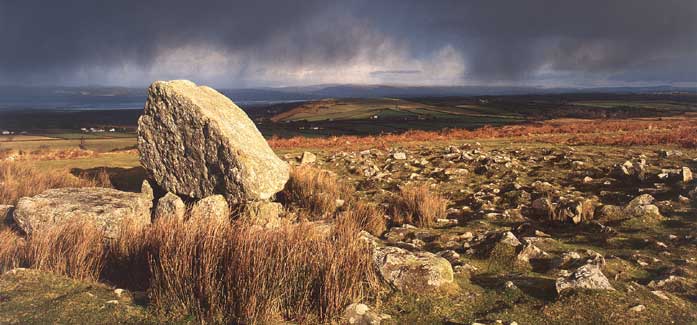Reynoldston
Arthurs Stone
Reynoldston
Located on the southern flank of the massive hillside of Cefn Bryn, the sprawling village of Reynoldston lies at the centre of Gower on an intersection that serves every corner of the peninsula. A small community settled here in the 6th century around a church that now provides the site of St George’s Church, a 19th-century construction containing a font constructed from a stalagmite thought to be from a local Gower cave, and a 10th-century pillar cross, one of the oldest Christian monuments on Gower. The village takes its name from Reynold de Braose, a Norman lord who settled here circa 1100. The large King Arthur Hotel is a dominant feature, serving good hearty food to hungry families.
Cefn Bryn is a great ridge of Old Red Sandstone rising to 610 feet and running much of the length of the peninsula. It dominates the view from most locations in Gower. Predominantly common moorland, Cefn Bryn is bare and bleak but forms a magnificent counterpoint to the views of the rocky coastline and sea that constantly.
Some seventy Neolithic burial mounds are scattered across Cefn Bryn, the largest being Great Carn, a circular mound of rocks covering a vast grave. To the north of the road heading east from Reynoldston looms the most famous of these, Arthur’s Stone, dating from 2500 BC. It is a vast 25-ton capstone deposited here during the last Ice Age and perched on great stone supports. At some stage long ago the capstone was 10 tons larger, but mysteriously a section broke clean off and now lies at the foot of the monument, a source of constant speculation and folklore as to how this came to pass. Many fables are attached to Arthur’s Stone (Maen Ceti in Welsh), some of them inevitably involving King Arthur himself. He is said to be seen sometimes riding a white horse near the monument.
Arthur's Stone
One mile south-west of Reynoldston is the hamlet of Knelston, with a ruined 12th-century church. An ancient broadleaved woodland known as Berry Wood lies about 500 metres south-east. Just beyond Knelston is Llanddewi, where the 13th-century church of St David has a chancel and nave that are out of line. Some say that this is a reminder that when Jesus Christ was crucified, he leant his head to one side. Others, more prosaically, suggest that the two were simply built at different times, presumably by slightly incompetent builders.


